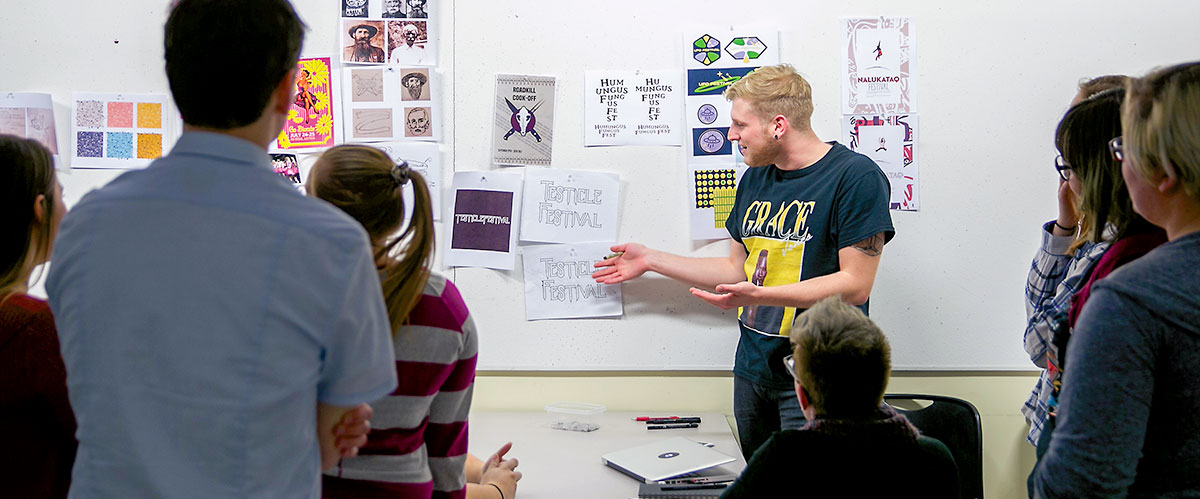Certificate Program
Communication Design
This program offers the foundational skills, concepts, and practices needed for designers to work successfully in interdisciplinary settings and teams.
Since a picture speaks a thousand words, companies and brands rely on visual design to quickly and clearly communicate values and personality, in order to connect with customers. To stand out and be noticed, effective graphic design is essential. The Communication Design certificate will provide the foundational skills to use industry-standard software for the production of a wide array of graphical communication needs.

The Bureau of Labor Statistics projects 2.9% employment growth for graphic designers between 2020 and 2030. In that period, an estimated 7,300 jobs should open up.
Course sequence
18 Credits | Not Available Online
GI 205 Typography I
In this class, students will initially work manually with letterforms to gain a craft-based aesthetic knowledge of type and eventually move toward a digital application of type and typographic design. Projects will stress the importance of appropriate type usage while addressing issues of craft, readability, message, and style. The software of the Adobe Creative Suite will also be explored.
Credits: 1.5
GI 217 Digital Technology I
The goal of this course is to teach students how to use the computer as a production tool. The software of the Adobe Creative Suite, including but not limited to InDesign, Illustrator, and Photoshop will be taught in order to address current industry standards and requirements. Utility programs, prepress and web issues, and file preparation and management skills will also be taught.
Credits: 1.5
GI 201 Visual Communication
An entry-level, concept-based studio stressing creative problem-solving. Throughout the course, students will be challenged to create artwork that is an effective union of concept, medium, and craft while addressing theoretical and practical applications. Emphasis will be placed on developing the best concept for each assignment and then learning the process that takes an idea through a linear progression of refinements to a finished piece.
Credits: 3
GD 206 Typography II
Typography II deals with type as a “volume” and in multi-page productions such as newsletters, magazines, and annual reports. Projects will stress the importance of grids, style sheets, master pages, etc. while exploring the nuances of the software Adobe InDesign.
Credits: 3
GI 218 Digital Technology II
While good design, illustration, and creativity will be expected, the goal of this course is to teach students how to use the computer as a production tool. The software of the Adobe Creative Suite, including but not limited to InDesign, Illustrator, Photoshop, and Adobe Acrobat will be taught to address current industry standards and requirements. Utility programs, prepress and web issues, and file preparation and management skills will also be addressed.
Credits: 1.5
GD 217 UX/UI Design
Introduces students to strategy, content development, and design thinking for the Web. Students will learn current prototyping methods and programs for site development.
Credits: 1.5
GD 311 Junior Design Studio I
This course focuses on corporate identity and brand development — the varied uses of the mark and brand— showing the power that visual communication components must achieve. Emphasis is placed on strong, and influential solutions and techniques of approach. Projects range from personal branding (mark, stationery system, and résumé), to corporate logo design and brand collateral, including collateral literature design and other peripheral materials.
Credits: 3
GD 312 Junior Design Studio II
This studio will challenge students with more sophisticated design problems and issues of branding while the students learn to work collaboratively as part of a team.
Credits: 3

Course Goals
Students who successfully complete the certificate will be able to:
- Demonstrate the ability to judge, adapt and incorporate historical and/ or contemporary influences and perspectives in their creative and intellectual processes.
- Demonstrate a range of traditional and digital skills in the creation of a design that is an effective union of concept, medium, and craft.
- Demonstrate deliberate and effective communication through an informed and influential visual and verbal language unique to the communication and interactive design industry.
- Engage in the business and practical realities of the communication and interactive design industry business trends and standards.
Career Opportunities
Graphic designers are needed in every industry. Manufacturing, packaging, healthcare, corporate visual identity, marketing & advertising, and publication are just a few of the places where this certificate will help you advance or get a foot in the door, for entry-level design jobs such as visual designer, production designer, digital designer, designer, and agency/studio designer.
Who Should Enroll
The program is designed for a wide range of individuals. Creativity is one of the most important skills for communication design. If you also have good communication skills and a basic appreciation for typography, branding, and delivery of information in a format that is appealing to the intended audience. College experience is not a prerequisite for this program, but a fondness for working with data and visual design is essential. High school and college graduates, veterans, professionals, and entrepreneurs will be among the students who bring their diverse perspectives to the program.
Cost
$1,305 per credit hour
A total of 16.5 credit hours are required. Credits will be billed per course.
How to Register
Enrolling in one of PCA&D’s Certificate Programs is simple. Confirm your intent to pursue one of our certificates by filling out an application.
If you have any questions regarding mapping out a plan, upcoming class schedules, or completing your certificate, please contact an Admissions Counselor at 717.396.7833 ext 1001 or email admission@pcad.edu.
